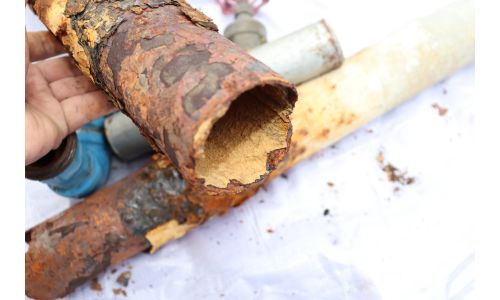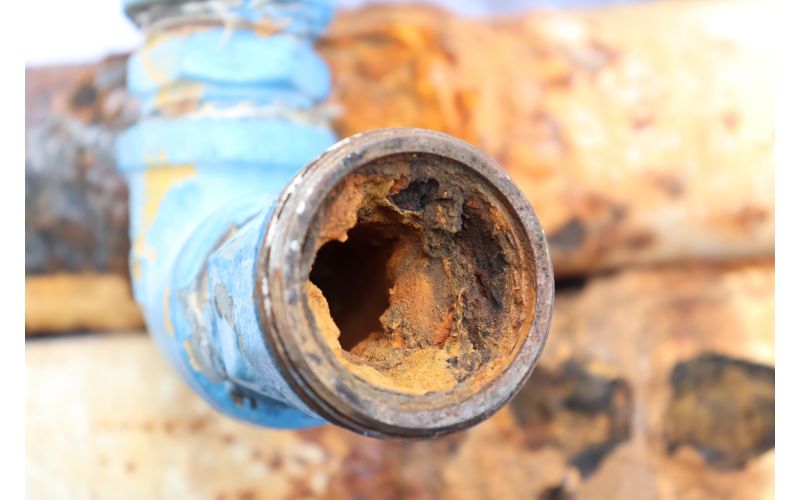Rusting is a pretty common problem with metal pipes, especially among old ones. If a pipe develops rust inside it, the water could be contaminated. Using that, contaminated water might spread water-borne diseases.
There are several methods to remove rust from inside pipes. Some homemade remedies can be used to remove rust from small areas. However, for bigger areas, a rust dissolver is preferable. Either way, rust needs to be removed as fast as possible.
We aim to emphasize how we can remove rust from the pipes inside. We will also discuss the checking procedure of pipelines’ health and some other related topics. Hence, let’s read thoroughly.
What Causes Rust Inside Pipes and How to Detect?
Rust is a reddish-brown iron oxide coating. Usually, it is visible on the surface of old iron alloys. It corrodes the alloy and causes it to leak. If it forms inside a water pipe, it could pollute the water too.
A rusty pipeline will exhibit certain distinct signs. The color might seem a touch off. In rare instances, even a few microscopic particles could be discernible in the water. However, to properly detect the rust, some measures need to be taken into account.
Here are some indications that pipes may be rusting inside and some of the causes.
Causes of Rust Inside Pipes
Rust inside pipes occurs due to oxidation and corrosion. The probability of rusting is higher for older pipes. Besides this, some other factors contribute to rusting, such as high chemical, pH levels, certain minerals, etc. Except for these, some other possible causes are:
- Hard or high mineral water
- Age of pipes
- Pipe’s material
- Chemically rich water
Detection of Rust Inside Pipes
Corrosion can be detected in a pipe if:
- The water tastes strange
- There is a leak
- The drains are clogged
- The water is lower than usual
- Uneven water distribution
These corrosion indications are usually produced by oxidation and the natural aging of pipes. Corroded water pipes can create leaks and taint your water, putting your plumbing system at risk of causing health issues.
How to Remove Rust From Inside Pipes- Necessary Tools And Steps
To remove rust from inside pipes, the first thing needed is suitable tool/ tools such as:
- A steel pick
- Rust removal solution
- Rags or cloth
- Plastic bottle
- Water
- Drill
- Wire brush etc.
Some different types of pipes can be victims of rusting. And when rust forms inside a pipe, it could be difficult to remove. We aim to discuss the step-by-step procedure of how we can remove rust from the pipes inside here.
How Can We Remove Rust from Inside of A Cast Iron Pipe?
Iron cast pipes usually last for a long time. They are extremely powerful and durable. They are, nevertheless, prone to oxidization. As a result, they may corrode with time. It could contribute to forming rust in the pipes inside.
If the rust is not removed, it will progressively develop throughout the entire pipe. Finally, it would create leakage and breaks. Though it takes time and a lot to do to repair corroded cast iron pipes, it not only refines the pipes’ features but also maintains them for a long time.
We would go over the step-by-step process of eliminating rust from an iron cast here.
- Step 1– Check that the main water line is turned off. It will avoid any unexpected water bursts.
- Step 2 – To clear the clog in the pipe, if the rust hasn’t set and if the clog is accessible, use a steel pick to pry out the rust bits.
- Step 3 – If the rust causing the blockage is unavailable, rust removers like Calcium, Lime can be used. Pour it down the pipe, where it will soften and dissolve the clog over time if the pipe is horizontal. If the rust is at the knob, spray the remover and let it stay for a few minutes before rinsing it with soapy water.
- Step 4 – After clearing the rust blockage, turn on the water. You might notice the water is brown. Let it flow for a while and it will eventually clear up.
How Can We Remove Rust from Inside of A Galvanized Pipe?
Galvanized pipes are strong, zinc-coated pipes. They are mostly utilized for domestic water delivery. However, the protection barrier might be eroded over time, resulting in rust inside the pipes.
We went over the step-by-step technique for removing rust from within pipes.
- Step 1 – Turn off the main water supply line first.
- Step 2 – Make the pipe empty by draining out all the water inside of it.
- Step 3 – Use any water softener. White vinegar or a chemical softener are both options.
- Step 4 – Remove the rust from within pipes with the help of an electric drill. It entails the subsequent actions.
- Step 5 – The outer nozzle should first be taken out of the pipe.
- Step 6 – Maintain a smooth water surge flowing through the pipe.
- Step 7 – Utilizing the drill, gradually remove the rust.
- Step 8 –Pipelines should be disconnected and secured if necessary while drilling.
- Step 9 -Use a screwdriver to remove rust from the T-connections of pipes and elbows.
- Step 10 – Connect the pipes once more, then turn on the water to clean them.
However, if the rust is severe and complicated, ask a plumber or an expert to help. Also, you should never try to replace the pipeline alone. Because due to the complex procedure, you can damage the pipe. Also, you might face an accident. We have also shared a YouTube video to help you with removing rust from inside pipes.
What To Use to Remove Rust from the Surface of a Pipe
To remove rust from the surface of pipes, any of the following methods would work.
Method 1: Using vinegar
Tools: white vinegar, some brushes (preferably steel), water, rags, and a bucket.
Procedure:
- Disconnect the pipe and put it in a bucket of vinegar. Let it soak for a night.
- Take the pipe out from the bucket and use a brush to remove the rust.
Method 2: Using baking soda
Tools: Water, baking soda, a sponge or rag, a small brush, and a towel.
Procedure:
- Soak a rag in water and clean the pipe with it.
- Spread baking soda all over the rust and let it stay for one hour.
- Scrub it with the brush and remove the rust completely.
- Now, wash it with water and wipe it with a towel.
Method 3: Using the salt and lemon method
Tools: Salt, lemon, warm water, rags, and brush.
Procedure:
- Cover the rusty area with salt and lemon juice.
- For new rust, keep the cover for half an hour, and for old rust, keep it for around two hours.
- Scrub the pipe with a brush.
- Wash the pipe and wipe it with a rag.
Frequently Asked Questions For Inside Pipes
Here we again to help you with some common inquiries about the removal of rust from inside pipes.
Q: Should I replace the rusty pipe?
The answer could be both yes and no. If the rusted portion is minor, you can just remove it and keep the pipe. However, you need to replace a cracked or leaked pipe due to rusting. Talk to a plumber if you need to replace the water pipe.
Q: How do I prevent rust from forming inside pipes?
Make an additional layer or barrier using waterproof sealants or basic paint. Moreover, use pipe insulation; it will keep moisture from coming into contact with the pipe.
Q: How can you get rust off a bent pipe?
Soak an old rag or an inexpensive dishcloth in vinegar and wrap it around the rusty exhaust area. The longer the cloth is left in place, the better the outcomes will be. After some time has passed, remove the cloth and use water to clean away the dislodged rust from the pipe.
Last Words
Rusting is a natural process. It happens over time and could damage the substances from which rust forms. It could also cause some health issues. So, the water pipe needs to be monitored from time to time.
Also, as of now, you know how to remove rust from inside pipes. You can either use homemade remedies to remove the rust in a small area or use chemical products and mechanical tools to remove rust from a larger area inside pipes. So, you can easily follow those procedures and live a healthy life.

